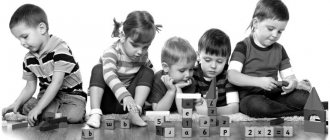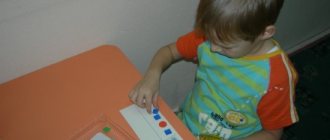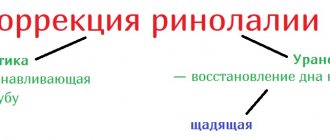Article:
Mental retardation is one of the most common childhood pathologies. About 50% of all low-achieving schoolchildren are diagnosed with this condition. Moreover, most of them study in regular general education schools, not correctional schools, despite the fact that they are not able to master the knowledge provided for in traditional programs. As a result, a lot of problems arise for teachers (how to teach) and parents (how to develop). In fact, mental retardation in children is not a death sentence at all. Competent and regular classes are a guarantee of successful psychocorrection work.
What it is
Mental retardation is a mental retardation when the basic cognitive functions (thinking, memory, attention, emotional-volitional sphere) in a child are not as well developed as those of peers and differ from the norms established for a given age. Diagnosed only in children of preschool age or primary school. If signs of the disease remain at the time of transition to secondary care, more serious diagnoses are made - for example, constitutional infantilism or mental retardation.
The term was proposed by the Soviet psychiatrist G. E. Sukhareva in 1959. Widely used in psychological, pedagogical and medical practice and literature. However, at the end of the 90s of the 20th century it was considered too generalized and already outdated, so the question of its replacement was raised. In 1997, this diagnosis was withdrawn from use by order of the Ministry of Health. They have been replaced by new concepts corresponding to codes F80–F89 and F90–F98 in ICD-10. These include all kinds of psychological development disorders (but no longer mental disorders):
- expressive and receptive speech disorders;
- hyperkinetic disorders;
- dyslexia;
- dyscalculia;
- dyspraxia;
- dysgraphia;
- behavioral disorders;
- phobias;
- tics;
- enuresis;
- encopresis;
- stuttering.
Since 1997, the term is not applicable as a medical diagnosis and is not opposed to mental disorders. However, this concept continues to be widely used in Russian-language psychological and pedagogical literature and Russian educational institutions.
Causes
All causes of mental retardation are divided into two large groups.
Biological
Pathologies and complications during pregnancy:
- if the mother suffered severe toxicosis, infection, intoxication, or injury during pregnancy;
- multiple births;
- intrauterine fetal hypoxia;
- prematurity;
- asphyxia;
- Rhesus conflict;
- incorrect presentation;
- birth injuries.
Infectious, toxic and traumatic diseases leading to perinatal encephalopathy in the first years of a baby’s life:
- nuclear jaundice;
- operations under anesthesia;
- fetal alcohol syndrome;
- cardiovascular pathologies;
- minimal brain dysfunction, organic brain damage, traumatic brain injury;
- congenital visual and hearing impairments;
- low mobility;
- asthenia;
- malnutrition, neuroinfections, influenza, rickets, hydrocephalus, vegetative-vascular dystonia, epilepsy.
Biological reasons also include genetics. There are cases when deviations of this kind are diagnosed from generation to generation.
Social
These include:
- long-term limitation of life activity;
- social deprivation;
- communication deficit;
- unfavorable upbringing conditions;
- mild mental disabilities in parents;
- psychotrauma.
Among the unfavorable conditions of upbringing that lead to mental retardation, there are three most common ones.
Neglect
A child to whom parents do not pay sufficient attention from early childhood, do not engage with him, do not develop him, grows up to be affectively labile, impulsive and suggestible. Does not learn basic rules of behavior and has no intellectual interests. Successful learning requires a basic understanding of the world around us. Reminds me of Mowgli who found himself in civilization. As a result, abnormal personality development is diagnosed as mental instability. But this is not the same as pedagogical neglect.
Overprotection
A child who, from early childhood, is given too much attention by anxious and suspicious parents and is raised as a little “god” of the family. He does not know how to overcome difficulties on his own, or adequately correlate desires and needs with the necessary efforts. There is no willpower. This leads to emotional lability, lack of initiative, self-centeredness, and dependence on adults. As a result, psychogenic infantilism is diagnosed.
Authoritarianism
A child who is suppressed by authoritarian parents from early childhood experiences their aggression, rudeness, cruelty, and despotism. Physical violence is often used. Against such an unfavorable background, obsessions, indecision, phobias, neuroses, increased levels of anxiety, and autism develop. This is an emotionally immature person who is not aimed at achieving success. As a result, learned helplessness syndrome is diagnosed.
Clinical picture
Parents should be aware of the main symptoms of mental retardation characteristic of a particular age.
1 year
CPR is not diagnosed at 1 year of age. But a number of alarm bells may indicate a tendency towards it:
- Compared to his peers, the baby began to hold his head up, sit up, crawl, turn, stand up, walk, walk late;
- does not hold objects well;
- cannot coordinate movements;
- moves little;
- unemotional.
In this case, it is necessary to take into account the individual developmental characteristics of the baby and, if in doubt, consult a pediatrician or neurologist.
2 years
Deviations are indicated by:
- ignorance of one's own name;
- lack of response to the simplest questions;
- profuse drooling;
- sleep disorders;
- moodiness, tearfulness, irritability, aggression;
- difficulty maintaining attention on a specific subject.
3 years
- Poor vocabulary (no more than 20 words);
- speech defects;
- lack of basic understanding of the surrounding world (cannot name animals, household items, body parts);
- inability to formulate coherent speech;
- difficulty completing basic tasks;
- undeveloped imagination;
- uniformity of actions in the game;
- inability to concentrate;
- fast fatiguability;
- aggressiveness, hysteria.
4 years
At 4 years of age, mental retardation is already clearly diagnosed based on specific symptoms.
Physical:
- weak muscle tone;
- kinetosis;
- urinary disorders;
- headache;
- fatigue, weakness, lethargy, immobility.
Cognitive:
- inability to speak coherently;
- poor vocabulary;
- absent-minded attention;
- poor memory;
- inability to remember information visually or auditorily;
- lack of basic knowledge about the world;
- lack of formation of cognitive motivation.
Social:
- aggressiveness, distrust, wariness towards others;
- isolation, autism, self-absorption;
- reluctance to participate in joint games;
- infantilism;
- mood changes.
It is at the age of 4, with timely recognition of mental retardation, that corrective work must begin. In its absence, all these symptoms only increase and deepen at 5-6 years of age. Secondary signs appear: psychosomatic diseases and internal complexes develop, cognitive abilities deteriorate, and social maladaptation is observed.
At primary school age, mental retardation manifests itself more clearly. Such children differ from their peers in behavior and learning abilities. If parents and kindergarten teachers missed this moment and sent such a child to school, the teacher can no longer help but pay attention to this. He needs to master the minimum standard program, without which he cannot transfer such a student to another class. Therefore, at this stage, a medical-pedagogical commission is organized, a diagnosis is made and psycho-correctional work begins.
Education of children with mental retardation
It is possible for children with mental retardation to master the educational program, but this program must meet the following requirements:
- take into account the individual characteristics of the baby;
- involve parents and loved ones of the child in the learning process;
- include constant monitoring of development dynamics;
- Stick to multitasking learning.
Correctional training for mental retardation has several directions:
- developing;
- diagnostic;
- therapeutic and prophylactic;
- advisory;
- social and labor.
Characteristic
The psychological characteristics of a child with mental retardation are compiled according to those mental functions that are impaired in him.
Cognitive abilities
Thinking in children with mental retardation:
- normal level of development of visual and effective thinking;
- for the development of visual-figurative thinking, repeated repetition of the task is necessary;
- unformed skills to carry out analysis and synthesis operations;
- poorly formed verbal and logical thinking.
Correctional classes with children suffering from mental retardation should be aimed at developing thinking taking into account these features. They are able to classify objects according to one characteristic: color or shape, for example. The main thing is to eliminate distractions that significantly reduce performance, patiently repeat the task several times and rely primarily on visual-effective thinking, which is developed in them almost the same way as in their peers. In this regard, they have much better prospects for mastering the material when compared with those who have been diagnosed with mental retardation.
Memory in children with mental retardation:
- unstable;
- unproductive;
- involuntary prevails over voluntary;
- visual prevails over verbal;
- minimal self-control, lack of cognitive activity and motivation when learning and reproducing material;
- inability to use memorization techniques and organize memorization work;
- short-term memory is most affected;
- in the presence of interference, the memorization process practically stops;
- Material learned with great difficulty is quickly forgotten.
All of the above specific features of memory in children with mental retardation must be taken into account by teachers and psychologists when organizing classes and by parents when doing homework. The work should be structured in such a way that the support is involuntary and visual memory, and not voluntary and verbal.
Attention:
- scattered;
- weakened if information is presented verbally;
- unstable;
- reduction in parameters such as volume, selectivity, concentration and distribution.
Correction of attention is aimed at increasing volume and concentration. In classes, distribution and constant switching between different types of activities is necessary. Creative assignments are welcome.
Perception:
- superficial;
- slow process of formation of interanalyzer connections:
- deficits in auditory-visual-motor coordination;
- slow speed of building a single, integral image in a presentation.
Correction of perception is aimed at improving subject-research activities and mastering sensory standards. Games to improve coordination, spatial orientation and develop fine motor skills are welcome.
Speech:
- poor vocabulary;
- impaired sound pronunciation;
- unformed lexical and grammatical structure;
- problems with coherent speech;
- defects of the articulatory apparatus.
To develop speech, classes with a speech therapist are simply necessary. At home, parents need to read and talk more with their child. It is recommended to ensure that he constructs sentences correctly and that his speech is coherent.
Interpersonal communication
The process of interpersonal communication in children with mental retardation is difficult due to the inferiority of the prerequisites necessary for successful socialization:
- low cognitive motivation;
- insufficient speech activity;
- defective speech and mental activity;
- immaturity of many components of speech activity.
Therefore, interpersonal communication is characterized by the following features:
- episodic in nature (they are rarely included in games);
- working and playing alone;
- uncoordinated actions in pairs;
- role-playing game is not a joint activity, since there is practically no communication within it;
- inability to fully and clearly answer questions posed, formulate a question independently, speak out, listen to others, maintain a conversation;
- lack of attachment to anyone.
Children with mental retardation are much more willing to play with those who are younger in age. Often, against the background of failed interpersonal contacts, social phobia develops and serious problems with social adaptation arise.
Emotional-volitional sphere
In children with mental retardation, immaturity of the emotional-volitional sphere is observed. Its manifestations:
- emotional instability;
- lack of independence;
- lability;
- easy suggestibility;
- weakness of willpower;
- self-doubt, low self-esteem;
- causeless worry, increased level of anxiety;
- instant mood changes, contrasting emotions;
- inadequate cheerfulness, gaiety.
Children with mental retardation cannot correctly assess:
- situation: they react too aggressively to any failure and difficulties;
- emotional state of others: during the funeral they can laugh and have fun;
- own emotions.
This is interesting! Children with mental retardation, characterized by emotional immaturity, perfectly recognize emotions from facial expressions and pictures. Compared to their peers, they almost 100% find grimaces of anger, suffering and joy.
Article:
In accordance with the Convention on the Rights of the Child and the Universal Declaration on the Survival, Protection and Development of Children, every child must be guaranteed the right to development, upbringing and education, taking into account his individual capabilities.
These provisions apply to all children, including those with disabilities in mental and (or) physical development. N.N. Malofeev, exploring the evolution of relations between the state and society towards persons with developmental disabilities from ancient times to the present day in the West and in Russia, identified five periods of evolution.
1. From aggression and intolerance to awareness of the need for charity for people with disabilities (in Europe - VIII century BC - XII century AD, in Rus' - X century AD - XVIII century AD. ). It lasts from the moment the laws of Lycurgus were established, which secured the right to destroy the disabled until the state realized the need for charity for persons with severe developmental disabilities (i.e., social support).
2. From awareness of the need for charity for people with disabilities to awareness of the possibility of educating deaf children; from shelters through the experience of individual training to the first special educational institutions (in Europe - XII century - XVIII century, in Russia - beginning of the XVIII century, beginning of the XIX century). European countries have recognized the possibility and feasibility of educating children with sensory impairments. In Russia, the model for organizing the education of such children was borrowed and a precedent was created for the opening of special schools in the capital. During this period, J. A. Komensky (1592-1670) expressed his belief in the life-giving power of education, the transformative power of upbringing, regardless of the existing anomaly in the development and behavior of the child.
3. From awareness of the possibility of educating children with sensory impairments to recognition of the right of abnormal children to education (the formation of a special education system). (in the West - the end of the 18th century - the beginning of the 20th century, in Russia - 1806-1927). Most European countries legally recognize the right of people with disabilities to education and are beginning to develop national systems of special education (Austria, England, Germany, Denmark, Italy, France). I. Pestalozzi (1746-1827) substantiated the principles of working with the “stupid”: strength in training, the use of didactic materials, a combination of mental and physical labor, combining training with productive work. Jean Itard (1775-1838) determined the development path for severely mentally retarded children - development through training exercises of sensory organs and motor skills. Maria Montessori (1870-1952) creates an orthophenic school for retarded children, where she applies a system of sensorimotor education for mentally retarded children. Alfred Binet and Thomas Simon developed a psychometric test method based on the state of the communicative function of speech; determined the range of “norm” and deviations from it. In pre-revolutionary Russia, a network of special educational institutions was created, but a special education system was not formalized. E.K. Gracheva (1866-1934) published the first guidelines for working with severely retarded children. V.P. Kashchenko (1870-1943) created a school-sanatorium for defective children - the prototype of subsequent research institutions on the problems of abnormal childhood. G.I.Rossolimo (1860-1928) proposed his own psychometric method - the “method of psychological profiles”, which proposed to study a child’s memory stability, speed of memorization, interpretation of drawings, detection of absurdities, ability to combine, state of motor skills, imagination, observation. In the West and in Russia, special institutions are being organized for three categories of abnormal children: deaf, blind, and mentally retarded.
4. From awareness of the need for special education for certain categories of children with developmental disabilities to understanding the need for special education for everyone who needs it. Development and differentiation of the special education system (in Western Europe - early 20th century - 70s of the 20th century, in Russia - early 20th century - 90s of the 20th century). In Western Europe, the legislative foundations of special education, mechanisms for identifying, recording and diagnosing children with developmental disorders are being improved, and types of schools and types of special education are being differentiated. The fundamental difference between special education in the USSR is its qualification nature. The resolution of the Central Committee of the All-Union Communist Party of Bolsheviks “On universal education” proclaimed compulsory education according to a unified state standard, without introducing a specialized standard for students with developmental disabilities. The domestic scientific school of defectology is developing the methodological, theoretical and methodological foundations of special education (D.I. Azbukin, L.S. Vygotsky, A.I. Dyachkov, L.V. Zankov, Yu.A. Kulagin, K.S. Lebedinskaya, A.R. Luria, L.V. Neiman, M.S. Pevzner, F.A. Rau, D.V. Feldberg, Zh.I. Shif and others). L.S. Vygotsky (1896-1934) formulated new tasks of special pedagogy and special school; developed social pedagogy that removes negative social layers in the process of forming a child’s personality in play, learning and other types of activities; formulated the concept of “zone of proximal and actual development”; developed the idea of the compensatory capabilities of the body of an abnormal child. It should be noted that the Soviet system of special education, unlike Western European ones, was completely closed from the media, its development took place without dialogue with society and interested parents.
5. From equal rights to equal opportunities; from “institutionalization” to integration (West - since the 70s of the XX century, Russia - since the 90s of the XX century). In Europe, the leading trend in the development of the education system for children with special needs is “mainstreaming” or integration. The specificity and complexity of the modern period in Russia lies in the fact that from 1991 to the present, multidirectional trends and approaches have been operating simultaneously within the same system of special education.
As can be seen, the fifth period of evolution is currently underway: from equal rights to equal opportunities; from “institutionalization” to integration. The specificity and complexity of the modern period in Russia lies in the fact that from 1991 to the present, multidirectional trends and approaches have been operating simultaneously within the same system of special education.
We agree with the point of view of N.N. Malofeev, who argues that in Russia it is necessary to develop its own model, which would “work” to advance the integration of structures of mass and special education, but would not lead to the curtailment of special educational institutions, and would not block the development of a system of differentiated special education. The latter is also due to the presence of special educational needs in children with developmental disabilities.
N.M. Nazarova states that a person with disabilities, like all other people, in his development is aimed at mastering social experience, socialization, and inclusion in the life of society. However, physical and mental disabilities alter the development of a growing person. Disability is an integral change in the personality as a whole. Therefore, in order to solve an educational problem, such a person needs not only to master general education programs in a special way, but also to form and develop social adaptation skills: orientation in space and time, self-service and social orientation, various forms of communication, conscious regulation of one’s own behavior in society , physical and social mobility; make up for deficiencies in knowledge about the world around us associated with limited capabilities; develop need-motivational, emotional-volitional spheres; to form and develop the ability to live as independently as possible in society; develop an active and optimistic life position.
The special educational process for children with developmental disabilities should take place in special educational conditions, presupposing: the presence of modern special educational programs, taking into account the developmental characteristics of each child, an individual pedagogical approach (the use of special means, methods of education, compensation and correction), ensuring an adequate living environment , carrying out the correctional pedagogical process by special teachers, providing medical, psychological and social services.
The content of special education, its educational and training components depends not only on the characteristics of developmental disabilities, but also on the age period in which a growing person with disabilities is located.
It is known that the complexity and polymorphism of mental retardation in preschool children determine the diversity and versatility of the educational needs of children in this category.
E.A. Ekzhanova argues that the educational and upbringing needs of children of infant, early and preschool age are associated with the main lines of child development.
Knowing the pattern that heterochrony determines the development of a child in ontogenesis makes it possible, through increased influence on him during sensitive periods of life, to control his neuropsychic development, creating conditions for stimulation, development or correction of one or another function.
In recent years, it has been proven that early and targeted pedagogical work helps to correct violations and prevent secondary deviations in the development of children. However, at present, the organization of correctional assistance for young children with developmental disorders in a family raising a problem child is only in its infancy. In most cases, practical identification of children with mental retardation begins at 3 or 5 years of age. The main lines of development that are significant for a child with mental retardation are considered in two age periods: junior preschool age - from 3 to 5 years and senior preschool age - from 5 to 7 years.
The educational and upbringing needs of a child of senior preschool age include: improvement of general motor skills, development of fine manual motor skills and hand-eye coordination, voluntary attention, formation of systems of sensory standards, the sphere of images and representations, indirect memorization, visual orientation in space, imagination, emotional control, improvement of visual-figurative thinking, mental operations at the verbal-logical level; internal speech, development of coherent speech, verbal communication, productive activity, elements of work activity, norms of behavior, subordination of motives, will, independence, ability to make friends, cognitive activity, readiness for educational activities.
The above lines of development are different both in nature and in their role in the psychophysical and social development of the child. This is important to take into account when organizing educational, correctional and developmental work with preschoolers.
Due to the fact that mental retardation in preschoolers has varying degrees of severity, the conditions for raising and training such children may be different. In milder cases (with mental retardation of constitutional, psychogenic origin), it is possible to raise a child in a general education preschool institution. The educational needs of children with severe forms of mental retardation of cerebral-organic origin are met by a specialized preschool educational institution of compensatory or combined type. However, in both cases it is necessary to take into account the specific educational needs of children with mental retardation:
– a child with developmental disabilities cannot develop productively without a specially created and constantly supported by adults situation of success;
– there is a pronounced need for a preschool child with mental retardation to communicate with peers;
– the immaturity of the emotional sphere of a preschooler with mental retardation indicates the specific need of a child of this category for emotional and moral education, since the development of emotional control is the most important prerequisite for compensating for their existing deviations.
Taking into account the physical and mental characteristics and developmental limitations of students is laid down in the State Standard for General Education of Children with Disabilities or in the Special Educational Standard (1999).
The standard of special education in relation to each category of persons with special educational needs reflects the requirements for general educational training, correctional and developmental work, preventive and health-improving work, as well as for labor and initial vocational training.
The standard takes into account not only the individual developmental characteristics of a particular category of persons with special educational needs, but also the specifics of the sociocultural and ethnocultural conditions of their residence (the document contains federal and national-regional parts).
At the same time, the problem of standardization of special education in our country is new, and the part that relates to the school period of special education has been most developed to date.
It is known that the conceptual provisions of education are reflected in the principles, N.M. Nazarova identifies the principles of special education (Fig. 1).
Rice. 1. Principles of special education
E.A. Strebeleva recommends taking into account the principles of both general and correctional preschool pedagogy when developing educational programs for children with developmental disabilities (Fig. 2).
Rice. 2. Principles of preschool and correctional preschool pedagogy
At the same time, A.D. Goneev distinguishes the principles of special correctional pedagogical activities: the principle of systematic correctional, preventive and developmental tasks, the principle of unity of diagnosis and correction, the principle of taking into account the individual and age characteristics of the child, the activity principle of correction, the principle of integrated use of methods and techniques of correctional pedagogical activities, the principle of integration of efforts immediate social environment.
It is legitimate to use the concept of “educational technology” as an integrative designation for various methods of educational interaction between a teacher and students. V.A. Slastenin et al. indicates that “educational technology should be understood as a consistent interconnected system of teacher actions aimed at solving pedagogical problems, or as a systematic and consistent implementation in practice of a pre-designed pedagogical process. Pedagogical technology is a strictly scientific design and accurate reproduction of pedagogical actions that guarantee the success.”
In Fig. Figure 3 shows a diagram of the technology of correctional activities (according to A.D. Goneev, 2002)
Rice. 3. Technology of correctional activities
It is well known that in the special educational process, diagnosis, training, education and correction are organically interconnected and complementary. However, for the purpose of analytical study of various aspects of the special educational process, it is legitimate to separate the means, methods, methods and forms of diagnosis, training, education and correction of children with mental retardation.
In the diagnostic block, the leading task is to organize a comprehensive psychological, medical and pedagogical study, which consists in identifying the child’s immaturities or disorders in the cognitive, motor, somatic, emotional and personal spheres and behavior in order to clarify the diagnosis and develop an individual-oriented development program for the preschooler.
Diagnosis of children with mental retardation is based on a number of signs and includes several sections: clinical examination, speech therapy examination, psychological and pedagogical examination, neuropsychological examination.
The study of the child is carried out both during a diagnostic examination and during dynamic observation during the correctional and educational process.
Based on the diagnostic results, the child’s level of development is determined, a prognosis is made, and recommendations are developed for the development and correction of his deviations.
Solving educational problems is aimed at teaching children with mental retardation how to assimilate social experience, developing their cognitive activity, developing all types of children's activities, and preparing preschoolers for school education.
The educational process in specialized preschool institutions is carried out in accordance with special (adaptive) comprehensive training and education programs developed for each category of preschool children with developmental disabilities and approved by the Ministry of Education of the Russian Federation.
Features of the content and organization of classes in a specialized preschool educational institution are discussed in program documents and in methodological developments for the training and education of children with mental retardation.
L.S. Vygotsky emphasized that compensation for mental and sensory impairments in children is possible through the formation of higher mental functions, for which it is necessary to create favorable conditions. Taking into account these features, it is important to take into account the unevenness of the manifestations of the child’s cognitive activity and rely on those types of mental activity in which this activity is most easily evoked. That is, it is necessary to look for types of tasks that maximize the child’s activity.
For this purpose, in the process of teaching children with developmental disabilities, methods of organizing and implementing educational and cognitive activity, its stimulation and motivation, control and self-control are used. General pedagogical methods are always used in combination with each other.
Taking into account the educational needs of children with mental retardation, researchers rightly put in first place the use of practical and visual methods that form the sensorimotor basis of ideas and concepts about cognitive reality. Complementary to these methods are verbal methods.
Scientists pay special attention to the use of the play method, which is determined by the leading lines of development and the motivational needs of children with mental retardation. At the same time, N.M. Nazarova notes that the lack of life and practical experience, underdevelopment of mental functions that are significant for the development of imagination, fantasy, speech design of the game, and intellectual disability first necessitate teaching children with mental retardation to play and gradually including the game as a teaching method in the correctional educational process.
A number of authors point out the advisability of gradually teaching various skills to children with mental retardation.
T.A. Vlasova et al., S.G. Shevchenko, E.M. Mastyukov draw attention to the need for the child to pronounce individual stages of his activity, which contributes to a more accurate and complete analysis of the pattern of actions and comparison of his work with it.
Taking into account the specifics of the mental development of children with mental retardation, many scientists are inclined to use integrated forms of education. In other words, knowledge and ideas in different sections of the program should be consolidated in different types of activities.
No less important in working with children with mental retardation is the organization of the upbringing process, which is inseparably linked with special education, correctional work, and is present in all elements of the child’s life.
Educational tasks are aimed at solving issues of socialization, increasing the independence and autonomy of the child and his family, establishing moral guidelines in the activities and behavior of a preschooler, as well as nurturing his positive personal qualities.
L.S. Vygotsky believed that special education should be subordinated to social education. Agreeing with this position, L.B., Baryaeva et al. recommends that work on the social and personal development of children be directed towards the formation of the child’s image of “I”, “I-consciousness”; discovering a peer, perceiving him on a positive emotional basis and learning how to interact; development of business, non-situational-personal and non-situational-cognitive forms of communication; the emergence of a social orientation and the formation of social ideas; identification and awareness of various levels and types of social relations; developing the ability to reflect (model) these relationships in different types of activities; development of volition, programming and control.
Researchers consider practical and effective methods of education to be the most accessible and effective for preschool children with mental retardation: training, exercise, educational situations, play, manual labor, visual and artistic activities. These methods must be combined with various information methods. It is valuable to rely on visual information, accompanied by comments, explanations from the teacher, using examples from the life around the child, and the teacher’s personal experience. The latter is due to the fact that for preschool children, the actions, actions, views, judgments, and habits of the teacher are role models.
It must be remembered that among the incentive-evaluative methods, the use of punishment is effective only if the child understands that he has committed a bad act; if the punishment does not humiliate the child or cause him physical pain; if punishment is used infrequently and a habit of it is not developed.
When organizing the educational process, the teacher must be in a continuous creative search for individual methods, forms, means, their combinations and interactions.
As E.A. points out. Ekzhanov, the content and organization of correctional work should be aimed at developing compensatory mechanisms for the development of the psyche and activity of a problem child, at overcoming and preventing secondary deviations in the development of their cognitive sphere, behavior and personal guidelines in kindergarten students.
N.Ya. Semago, M.M. Semago is convinced that “correctional work of the modern type must not only take into account the entire structure and hierarchy of a particular variant of mental development, but also understand the path this development took, what are the reasons for the observed phenomenology, in particular, the existing level of formation of the basic components of development.” In this regard, they believe that in the basis of integrative correctional work it is necessary to use the “principle of replacement ontogenesis” (the principle of replacement development), formulated by A.V. Semenovich.
D.B. Elkonin distinguished symptomatic correction (aimed at eliminating the symptoms of developmental deviations) and causal (aimed at eliminating the causes and sources of deviations). However, in the preschool period, preference should be given to causal correction.
In recent years, traditional and non-traditional correctional technologies have been of great interest, which are being tested by scientists and practitioners, teachers and psychologists.
Children's leading activities are widely used in correctional work. Thus, various types of games are used to form the child’s personality, his relationships with others, to correct cognitive, emotional, volitional processes, and communication.
The studies of Zaporozhets and Neverovich showed the effectiveness of using creative activity in regulating the dynamic side of a child’s behavior.
Modern research by both domestic and foreign scientists assigns a large role to art as a means of correcting a child’s “I-concept”, his self-awareness, the need for communication, self-affirmation, recognition, and negative emotional states.
The role of music therapy in stabilizing the emotional states of children is determined by a number of researchers.
Aesthetotherapy ensures the mobilization of the internal protective and adaptive reserves of the child’s body by creating a feeling of joy in life.
A number of authors have proven that when using fairy tale therapy, metaphorical influence activates personality resources and leads the child on the path of independent discovery.
N.Ya. Semago, M.M. Semago analyzed a number of correctional programs of other researchers, which are currently widespread in educational centers. Thus, the methodology for developing programming of voluntary self-regulation and control over the course of mental activity is a complex of educational and game activities based on working with a number series. The foundations of a level approach to the development and correction of the emotional-personal sphere and basic affective regulation of the child have been developed. One of the methods of deeply psychologically oriented psychotherapy is symboldrama. The basis of this method is free fantasy in the form of images, “pictures” on a topic given by the psychotherapist.
To implement the “Formation of Spatial Concepts” program, it is recommended to develop the type of lesson in accordance with the age of the children and taking into account the leading type of motivation (play, competitive, achievement motivation, learning, reward or avoidance of punishment).
In studies conducted by E.A. Panko, S.N. Zhdanov, L.S. Khodonovich, it was revealed that correction is most successful if it is comprehensively implemented both through play and through different types of art with integrated interaction of specialized specialists.
Organizing the work of specialists in the correctional unit also involves teaching parents some psychological and pedagogical techniques that increase the effectiveness of interaction with a child with mental retardation, stimulating his activity in everyday life, and strengthening his faith in his own capabilities. When working with parents, both group and individual forms of work are used. E.A. Ekzhanova names the following principles of such work: systematic implementation of events; their target planning; taking into account parental requests when determining topics; focus on the final goal; taking into account parental socio-psychological attitudes and their correction during interaction; the presence of a specific performer (specialist) responsible for carrying out the events.
It is known that children with special educational needs have the right to receive qualified pedagogical assistance. However, in the Russian special education system, only about 10% of teachers have the education of a defectologist (in European countries and the USA - 95-98%), and from 47 to 70% of teachers experience difficulties in organizing educational and correctional work with children with disabilities. development and behavior.
A special teacher acts as a civil servant, social worker, educator, defectologist, rehabilitation teacher, social teacher.
The general requirements for the professional and pedagogical activities of teachers working with children with developmental disabilities are determined by the Model Regulations on Compensatory Education Classes (1992), the State Educational Standard of Higher Professional Education (2002), the Model Regulations on Preschool Institutions (groups) of Correctional Development education and training of children with mental retardation (1997).
In general, as noted by A.D. Goneev, Yu.K. Chernyshenko, S.D. Neverkovich, readiness for teaching activity is presented as an integral model, manifested in the interaction of several components of the teacher’s personality: motivational and value-based; cognitive; operational and practical; emotional-volitional and reflective.
So, analyzing the above, it can be noted that in special education the processes of diagnosis, training, education and correction should be interconnected and complementary. In the process of educating and training persons with special educational needs, special educational technologies, methods of teaching and upbringing, and means of correction are distinguished. Educational, correctional and developmental processes are carried out with children with mental retardation disorders, both in everyday life and in specially organized classes. Working with children with mental retardation presupposes that the teacher has special education and that the personal psychogram corresponds to the special teacher’s professional profile. An indispensable condition for the effectiveness of the correctional and developmental process is the integrated activity of specialists and parents (families) with children with special educational needs.
Psychological characteristics
A child with mental retardation has features of mental development that differ from the symptoms of other similar pathologies. This is necessary to know to differentiate the diagnosis.
Differences from mental retardation:
- partial rather than complete impairment of cognitive activity;
- high potential for further development;
- It is not the mental functions themselves that suffer, but the prerequisites for intellectual activity (phonemic hearing, speech, attention);
- spasmodic dynamics of mental activity;
- ability to cooperate with adults;
- the presence of emotions in gaming activities;
- a vivid manifestation of emotion;
- often have a knack for drawing.
Differences from pedagogical neglect:
- lack of education and attention from adults is only one of the reasons, while in neglected children it is the only one;
- behavior is caused by deviations in the emotional-volitional sphere and cognitive abilities, and not by problems in moral and legal consciousness;
- are rarely distinguished by deviant behavior and rebellious character;
- know how to interact with adults.
The success of treatment and correction will depend on the correct diagnosis.
Raising a child with mental retardation
Many parents are sensitive to the diagnosis of mental retardation in their child. But it should be remembered that this is not a mental illness, but only a temporary lag in development in comparison with peers, which can be made up.
Remember! With proper development and support, as well as compliance with all recommendations of doctors and specialists, by the age of 10, you can completely get rid of the symptoms of mental retardation in a child.
Classifications
Classification by Pevzner and Vlasova
M. S. Pevzner - defectologist, psychiatrist, psychologist, candidate of medical sciences and doctor of pedagogical sciences. Professor. T. A. Vlasova is a psychologist, defectologist, Doctor of Psychology, professor, academician. Years: 1972-1973.
- Uncomplicated psychophysical and mental infantilism
The emotional-volitional sphere corresponds to the development of younger children. Playful activity prevails over cognitive activity. This leads to inattention and learning problems.
- Secondary ZPR
The exhaustion of mental functions is caused by various biological factors that occurred during pregnancy or in the first year of the baby’s life.
Lebedinskaya classification
K. S. Lebedinskaya is a child psychiatrist and defectologist. Year: 1982. The basis is the classification of Pevzner and Vlasova, supplemented and expanded.
- Constitutional ZPR
Corresponds to uncomplicated mental and psychophysical infantilism according to the classification of Pevzner and Vlasova. Such children show bright, but superficial and unstable emotions. They are always in a high mood, they are mediocre and naive. They are distinguished by their gracefulness - an infantile body type. ZPR is caused by hereditary factors and complications during pregnancy.
- Somatogenic ZPR
Firstly, it occurs against the background of diseases suffered by the baby in the first year of life. Secondly, it is complicated by neurotic deviations. Such children are not self-confident, fearful, capricious, and feel their physical inferiority. All this ultimately leads to somatogenic infantilism - delayed emotional development.
- Psychogenic mental retardation
The main reason is unfavorable upbringing conditions, starting from a very early age and lasting for a long time.
- Cerebral-organic mental retardation
The most common type of ZPR. I. F. Markovskaya (Candidate of Psychological Sciences, Associate Professor) identifies another mini-classification within this group (1983).
1. Mental instability. Manifests itself in the form of hyperactivity, excessive noise, loudness, rudeness and conflict. But these children’s emotions are short-lived, so within a minute they will be playing with those with whom they just quarreled or even fought.
2. Mental retardation. Such children are dependent, indecisive, timid, slow, and too attached to their parents. They do not participate in joint outdoor games with others, they quickly get lost and cry when something is demanded of them.
Kovalev's classification
V.V. Kovalev - psychologist, psychotherapist. Year - 1979.
This is a classification of mental retardation caused by biological factors:
- dysontogenetic - mental infantilism;
- encephalopathic - organic lesions of the nervous system;
- secondary due to sensory defects - visual and hearing impairments;
- social deprivation - hospitalism.
Today, Lebedinskaya’s classification is most actively used in practice. Although she will soon be 40 years old. In connection with new standards of training and the changed realities of modern life, experts have long been talking about the need to create a more relevant typology of ZPR.
Classification of mental retardation according to the epigenetic principle. Causes of mental retardation
- 75% of cases of mental retardation are a delay of cerebral-organic origin, that is, it is based on insufficient functioning of the brain and its pathways (often the consequences of an unsuccessful pregnancy, problems during childbirth, etc.).
- ZPR of constitutional origin. The so-called harmonious infantilism, when psychophysically the child is somewhat behind his peers. This is due to hereditary reasons. A child may be more suggestible and emotional than his peers. In general, he looks younger (the difference with his real age is 1-1.5 years).
- ZPR of somatogenic origin. Here the delay is due to the weakening of the body, frequent, chronic somatic diseases of the child. The general tone of the child’s body and psyche is reduced. Often the situation is complicated by overprotection from the family.
- Mental retardation of psychogenic origin (this also includes pedagogical neglect). The reason is unfavorable psychosocial conditions. Previously, it was generally accepted that such a delay could only occur in children from disadvantaged families (unemployed, parasites, alcoholics, etc.). Nowadays, there are increasingly cases where, despite financial wealth, the type of upbringing in the family is inharmonious, in particular, the child does not develop the necessary level of self-regulation, awareness, self-care due to overprotection, inconsistency, educational insecurity, and anxiety of parents.
Diagnostics
The presence of mental retardation in a child can only be confirmed by special diagnostics. Specialists in the field can understand the nature and depth of existing violations during a comprehensive examination:
- psychotherapist;
- speech pathologist;
- psychologist;
- speech therapist;
- pediatrician.
All of them are included in a special medical and pedagogical commission, at which the diagnosis is confirmed or refuted, a final decision is made, and recommendations are given on the further development of the child. In addition to psychological characteristics, they carefully study dynamics (data are provided for the last 2-3 years):
- school performance;
- the nature of errors in mathematics and the Russian language;
- handwriting features;
- state of motor skills;
- pace of activity and many other aspects.
The commission is also provided with the results of a full medical examination and medical history.
Based on the data obtained, a conclusion is made whether the child has mental development delay. But, as mentioned earlier, a medical diagnosis of mental retardation has not been made since 1997. In conclusion, terminology from the following part of ICD-10 is used:
Prevention of mental retardation
Prevention of mental retardation includes, first of all, a responsible approach to pregnancy planning. During the period of bearing a child, the mother should try in every possible way to avoid any negative effects on the fetus.
At an early age, the benefits of preventing infectious and various somatic diseases are undeniable. It is important to provide favorable living conditions for the child. If there is the slightest suspicion that a child is developing psychomotor processes, it is necessary to conduct an examination by specialists and promptly begin work to eliminate the condition.
Education
Where and how can a child with mental retardation study:
- integrated education in secondary schools;
- correctional and developmental education based on a person-centered approach in general educational institutions;
- training in educational institutions of the VII type, where all the features of the educational activities of children with mental retardation are taken into account as much as possible.
In 2015, an important document was approved regulating the education of children with mental retardation in secondary schools. This is the “Adapted basic general education program for primary general education for students with mental retardation.” It is included in the “Special basic general education programs of primary general education of the Federal State Educational Standard”. This system is being implemented in regular educational institutions (not correctional) throughout the Russian Federation from September 1, 2021 in accordance with the Letter of the Ministry of Education and Science of the Russian Federation dated June 7, 2013 “On correctional and inclusive education of children.”
From this moment on, children with mental retardation have every right to study not in a correctional school, but in a regular general education school, together with their normally developing peers. In this case, teachers and parents should take into account the following teaching features:
- they require more attention and individual approach;
- they study according to a separate, simplified program;
- Problems in mastering the material are not due to laziness and negligence, but to inability.
Educational psychologists insist that it is much more productive to send a child with mental retardation to a specialized correctional school or transfer him to home schooling.
Which specialists work with children with mental retardation?
The educational process involves not only educators who have undergone special training in working with children with mental development disorders, but also defectologists, speech therapists, psychologists and physical education workers.
Due to the behavioral characteristics of children with mental retardation, they are able to perform only those tasks that are related to their personal interests.
For young children, the predominant activity is play, so it is through play that children with mental retardation learn.
For this purpose, many different games and exercises have been developed aimed at developing thinking, ideas about the world around us, memory, attention and social adaptation of the little ones.
Treatment and correction
Depending on the type of mental retardation and the individual characteristics of the child, specialized specialists develop a correctional and developmental program for the child to study. It includes various blocks that provide an integrated approach to solving existing problems.
Microcurrent reflexology
This is a hardware effect of electrical impulses on bioactive points of the brain, the so-called neuroreflex zones. Targetedly restores the functioning of the nervous system exactly where there are disturbances. Microcurrents selectively process the brain centers responsible for intellectual abilities, speech activity, diction, and vocabulary.
Organized in a hospital setting. True, not all parents give consent to the procedure.
Psychological and pedagogical correctional classes
A child with mental retardation should regularly attend psychologist classes. The goal is to adjust mental development in such a way that it improves his quality of life. Among the main tasks:
- increase the level of intellectual, emotional and social development;
- develop gross and fine motor skills;
- expand your vocabulary and conceptual apparatus.
Parents have the right to know what the program of the psychologist who works with their child includes. Points that raise doubts or mistrust must be agreed upon in advance.
Psychological work with children suffering from mental retardation involves the use of a variety of techniques.
Psychotherapeutic areas:
- isotherapy;
- sand therapy;
- music therapy;
- puppet therapy;
- fairytale therapy;
- logorhythmics;
- methods of object-sensory therapy.
During classes, the psychologist organizes didactic games with multi-colored stripes, cubes, sticks, geometric shapes (including three-dimensional ones) and special cards. Examples of several such games are presented below.
"Guess the Emotion"
It is carried out either in a group of 5-6 similar children with mental retardation, or in pairs with a psychologist. Cards with schematic representations of various emotions are placed on the table. It is proposed to take one of them at random, name what is in the picture, and try to depict this feeling using facial expressions, voice, and gestures. You can make the task more difficult and ask them to name the situation in which this emotion most often manifests itself.
"Find the number"
Pictures and three-dimensional figures of different numbers are laid out on the table. They all differ in size and color. The psychologist names a number - you need to select all the matches from the proposed material (for example, all twos or eights).
"Mood Lotto"
There are cards on the table with animals with different faces on them. The psychologist names an emotion (shows a picture of it or depicts it himself) - the child must choose the right card for it.
"Magic bag"
Small voluminous things that are easily recognizable by touch are put into a beautiful bag: a mirror, an alarm clock, a pencil, a notepad, a ruler, etc. You need to put your hand in there with your eyes closed, take out any object and guess what it is.
"Mood Palette"
There are cards with different shades of mood on the table. The psychologist asks the question: “How do you feel now?” — the child must answer using a drawing. After this, the question is transformed several times: “How is your mother feeling today?”, “What do you think is your cat’s mood?” etc.
Alternative techniques
Additionally, specialized specialists can prescribe modern, non-traditional correction methods:
- hippotherapy;
- canistherapy;
- dolphin therapy;
- feline therapy.
Timely and competently carried out psychocorrectional work gives positive results.
Card index of educational games for children with mental retardation
The following games are useful for children with mental development disorders:
- "Repeat after me" . It consists of repeating certain movements and actions for adults. The game improves motor skills and voluntary attention
- "Guess whose sound" . An adult introduces children to various objects (scissors, whistle, bell, rattle, paper), shows what sound they can make. Then behind the screen he plays a sound with one of the objects, and the children guess what it is. The game develops perception and auditory attention.
- “Repeat the figure . The task is that children are given cards with a picture of a figure made from counting sticks. Kids must reproduce the shapes on the table or, if unsuccessful, lay out the pattern on the card using the “overlay” method. This game develops motor skills, attention, visual perception and teaches action according to a model.
- "Whether it flies or not" . An adult names objects and living beings, and children must show whether a given object flies or not. If it flies, the children wave their arms; if not, they keep their arms down. The one who makes a mistake is out of the game. The task helps to identify the characteristics of various objects and helps to learn to switch attention. The game can be changed to “Jumps or not” , “Swims or not” , etc.
- Reaction speed and hand-eye coordination can be developed with the help of the game “Edible - Inedible” .
- “Cooking borscht . An adult prepares two hoops, lays out various objects and divides the children into 2 teams. The kids run to the hoop for a while and choose vegetables to cook borscht. Teams are judged on their speed and correct choice of items. Similarly, you can play “Hospital” , “Barbershop” , using other objects. The game is aimed at speed of reaction.
It is useful to conduct relay races where you need, for example, to carry an object overcoming obstacles in the form of logs, pins, etc. Round dance games with poetic accompaniment allow you to unite children and make friends.
You can also read more about outdoor games for preschool children in our article HERE
Exercises for children with mental retardation
Various play-based exercises are also used to develop children with mental retardation.
Here are some of them:
- "Find your apple" . The adult invites the child to choose one from three or four apples and study it for a couple of minutes. Then the baby closes his eyes, the apples are mixed, and the child must find his apple using the highlighted distinctive features. The exercise trains memory and attention.
- "Clap your hands . The adult says that the children should clap their hands if he names, for example, an animal. With this exercise, kids practice switching attention.
- "Bell and Tambourine" . An adult beats a tambourine or rings a bell. In this case, children should, in the first case, walk around the group at a calm pace, in the second case, run after each other. The exercise teaches you to perform actions according to instructions.
- "Find differences" . The child is offered two similar pictures, and the child must name the differences. This helps develop concentration.
- "Remember where" . An adult lays out three to five cards on the table depicting different objects. The baby remembers them, then the cards are turned over, and the baby must show which object is where. You can modify the exercise. In this case, you don’t have to turn the cards over, but remove one card from the table until the baby sees, and then ask what’s missing. These exercises improve and train memory.
- “Complete the drawing . The child is asked to complete the second part of various simple objects on the cards - a ball, a sun, a butterfly, etc. The exercise helps develop the integrity of perception.
- "What's extra" . The cards show four objects, one of which is extra. The child must name the extra object and answer on what basis they differ. You can use groups of vegetables, fruits, plants, mushrooms, furniture, etc. You can also play “Find the extra word” in the same way.
To develop speech skills, articulatory gymnastics exercises are used, accompanied by thematic poems, which contain instructions for performing movements.
Breathing exercises are also useful. To perform gymnastics, you can use the exercise “Guess the smell” . To accomplish this, you can use vegetables and fruits. Children get acquainted with their smell, and then, blindfolded, try to guess what kind of fruit or vegetable the adult gave them.
What should parents do?
Psychologists and teachers who work directly with children who have mental retardation give useful recommendations to parents to speed up their development.
To begin with, parents will have to not only understand, but also accept the fact that the child will learn more slowly than his peers and lag behind them in his studies. In order not to demand too much from him, to be patient with his characteristics, they need to be studied and taken into account when communicating and studying.
Homework alone cannot solve the problem of mental retardation. Therefore, the second step for parents who want to help their child is to seek qualified help from specialized specialists - a special education teacher, a psychologist or a psychotherapist. Taking into account individual characteristics, they will give recommendations on what exactly needs to be done.
General tips:
- Exercise daily for 30-40 minutes.
- Pay more attention to the child, organize time together, communicate, involve other relatives.
- Provide a comfortable atmosphere in the family.
- Normalize the daily routine, introduce a healthy lifestyle, provide a balanced diet, increase physical activity and stay in the fresh air.
- Communicate with other parents of the same children (for example, through communities on social networks).
- Organize communication with peers.
- Don't tell your child that he is special. Do not regret that he is not like everyone else.
- Assign household chores, animal care, teach self-care.
- Don't raise your voice, be patient no matter what happens.
- Keep a diary to note all your successes - these entries will help you adjust your future work.










